Exploring the Rich History and Uses of the Renowned Indigo Dye Plant Throughout Cultures
The Fascinating World of Indigo Dye Nature’s Blue Treasure
Indigo dye, one of the oldest and most revered colorants in the world, has a rich history and a myriad of applications that stretch across cultures and continents. Derived from the leaves of the indigo plant, particularly from species like Indigofera tinctoria, this natural dye has captured the imagination of artists, artisans, and fashion designers alike.
Historical Significance
Indigo has been used for over 6,000 years, with its origins tracing back to ancient civilizations in India, Africa, and South America. The dye became a valuable commodity for trade, often termed blue gold. In India, indigo cultivation was so significant that it played a pivotal role in agricultural practices. The dye was essential not just for textiles but also for religious and ceremonial purposes, symbolizing purity and divinity.
The popularity of indigo expanded during the colonial period, particularly in Europe, where it became a staple in the fashion industry. Its deep, vibrant blue made it a favorite among aristocrats and common folk alike, leading to an increase in its cultivation. However, this demand often came at a significant human cost, with exploitative labor practices emerging in plantations, particularly in the Caribbean and American colonies.
The Process of Extraction
The process of extracting indigo dye from plants is both intricate and fascinating. First, the leaves of the indigo plant are harvested and then fermented in water. During fermentation, the leaves release a compound called indican, which converts into indigo dye through oxidation. After fermentation, the liquid is collected and oxidized, resulting in the formation of blue pigment. This step is crucial; the dye can only achieve its vibrant hue through exposure to air.
Once the dye is extracted, it can be used in various ways, from traditional tie-dyeing techniques to modern applications in textile manufacturing. The dyeing process is labor-intensive, often requiring multiple dips in the indigo vat to achieve the desired intensity of blue.
famous indigo dye plant

Cultural Impact
Indigo is more than just a dye; it is a symbol of cultural identity in many regions. In Japan, the art of indigo dyeing, known as aizome, has been practiced for centuries, resulting in intricate designs and patterns that reflect the nation's aesthetics. Similarly, in West Africa, indigo is not only used in clothing but also holds significant cultural value, often associated with identity and heritage.
The revival of interest in natural dyes has led to a resurgence in indigo cultivation and dyeing techniques, particularly in artisan communities. As consumers become increasingly aware of environmental issues and the impact of synthetic dyes, the appreciation for natural dyes like indigo continues to grow. This shift towards sustainable practices is vital for preserving traditional craftsmanship and promoting biodiversity.
Modern Applications
Today, indigo dye is experiencing a renaissance, especially in the fashion industry. Designers and brands are increasingly seeking natural alternatives to synthetic dyes to create eco-friendly and sustainable products. From denim jeans to high-end fashion pieces, indigo remains a staple, beloved for its rich history and unique shades.
Furthermore, the growing movement towards slow fashion prioritizes sustainability, craftsmanship, and ethical production, making indigo an attractive choice. Artisans are now experimenting with novel techniques and blends to push the boundaries of what can be achieved with this ancient dye.
Conclusion
In conclusion, the indigo dye plant is not just a source of color; it is a bridge connecting us to our past and a potential path to a more sustainable future. As we celebrate the beauty and versatility of indigo, we also honor the cultures and communities that have cherished this dye for millennia. The journey of indigo from plant to fabric is a testament to the ingenuity of human craftsmanship and the enduring allure of nature’s palette.
-
The Timeless Art of Denim Indigo Dye
NewsJul.01,2025
-
The Rise of Sulfur Dyed Denim
NewsJul.01,2025
-
The Rich Revival of the Best Indigo Dye
NewsJul.01,2025
-
The Enduring Strength of Sulphur Black
NewsJul.01,2025
-
The Ancient Art of Chinese Indigo Dye
NewsJul.01,2025
-
Industry Power of Indigo
NewsJul.01,2025
-
Black Sulfur is Leading the Next Wave
NewsJul.01,2025

Sulphur Black
1.Name: sulphur black; Sulfur Black; Sulphur Black 1;
2.Structure formula:
3.Molecule formula: C6H4N2O5
4.CAS No.: 1326-82-5
5.HS code: 32041911
6.Product specification:Appearance:black phosphorus flakes; black liquid

Bromo Indigo; Vat Bromo-Indigo; C.I.Vat Blue 5
1.Name: Bromo indigo; Vat bromo-indigo; C.I.Vat blue 5;
2.Structure formula:
3.Molecule formula: C16H6Br4N2O2
4.CAS No.: 2475-31-2
5.HS code: 3204151000 6.Major usage and instruction: Be mainly used to dye cotton fabrics.

Indigo Blue Vat Blue
1.Name: indigo blue,vat blue 1,
2.Structure formula:
3.Molecule formula: C16H10N2O2
4.. CAS No.: 482-89-3
5.Molecule weight: 262.62
6.HS code: 3204151000
7.Major usage and instruction: Be mainly used to dye cotton fabrics.

